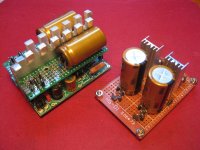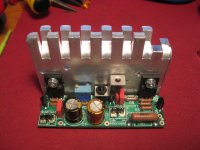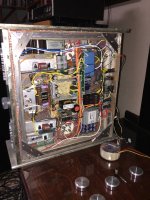I see your using DL92 tubes, those Philips are the best ones too 
I built a small amplifier with those tubes and changed from simple LM317 regulators to Rod Coleman filament regulators and the difference was night and day. Do your self a favor and forget about those off the shelf switching regulators and just fit the Coleman boards. For the tiny 1.4v 100ma filaments you can build both boards with a simple rectifier and filter cap into a very small space. The heatsink was total overkill, you could just mount them to the chassis.
I built a small amplifier with those tubes and changed from simple LM317 regulators to Rod Coleman filament regulators and the difference was night and day. Do your self a favor and forget about those off the shelf switching regulators and just fit the Coleman boards. For the tiny 1.4v 100ma filaments you can build both boards with a simple rectifier and filter cap into a very small space. The heatsink was total overkill, you could just mount them to the chassis.
Attachments
Last edited:
I built a small amplifier with those tubes and changed from simple LM317 regulators to Rod Coleman filament regulators and the difference was night and day.
There should not be any measurable or any other difference if the design and implementation of LM317 is correct.
Have you measured the differences, between a 317 and any purpose-designed current-driven filament regulators?
Start by measuring the ac-impedance: the differential impedance that the filament sees, looking outward.
The LM317 in current-source mode works better than a voltage regulator, but it can be improved a great deal.
Start by measuring the ac-impedance: the differential impedance that the filament sees, looking outward.
The LM317 in current-source mode works better than a voltage regulator, but it can be improved a great deal.
Have you measured the differences, between a 317 and any purpose-designed current-driven filament regulators?
No, but I guess you have, so would you tell how the improvement can be observed.
One way to measure supply impedance is to load it with a squarewave, a 1Khz square will consist of a lot of harmonics, and can be used to understand loop stability.
About the disadvantages of feeding tube heaters with constant current: Current Source as a tube heater supply
The only advantage of having a CC capability of say 150% of nominal current is that the inrush current on the heaters will be much lower, increasing heater life on tubes that are switched on and off a lot during use.
About the disadvantages of feeding tube heaters with constant current: Current Source as a tube heater supply
The only advantage of having a CC capability of say 150% of nominal current is that the inrush current on the heaters will be much lower, increasing heater life on tubes that are switched on and off a lot during use.
Last edited:
<cut>
The only advantage of having a CC capability of say 150% of nominal current is that the inrush current on the heaters will be much lower, increasing heater life on tubes that are switched on and off a lot during use.
Yes, the inrush is lower, and that is kind to the filament for long lifetime.
But the real reason to use current-driven heating - regardless of theoretical articles - is that this is the only way to avoid crushing the differential (music) signal across the filament. This is present in every DHT, because of the effect of the heating voltage, skewing the bias (Vgk and Vak) from one end of the filament to the other.
With voltage regulators (switching or linear), this part of the signal is short circuited - by the closed-loop feedback action of the regulator.
I don't need to say anything about the effect on the sound - you can simply search these forums, and find plenty of experiences, from many different constructors, all around the World.
Please compare for yourself - measure, and/or listen - and you will understand perfectly.
Please try the impedance measurement I suggested.
I do not intend to make any measurements, just want to discuss about this subject and see if somebody can provide reliable test results with different regulators or other components.
So far I have not seen any such result why LM317 can not perform as well as some other regulator circuit.
If the difference between LM317 regulator to Rod Coleman filament regulator, as mcandmar said is like: "difference was night and day." there obviously is something tangible between those applications, more than (so typical) better sound.
I see your using DL92 tubes, those Philips are the best ones too
I built a small amplifier with those tubes and changed from simple LM317 regulators to Rod Coleman filament regulators and the difference was night and day. Do your self a favor and forget about those off the shelf switching regulators and just fit the Coleman boards. For the tiny 1.4v 100ma filaments you can build both boards with a simple rectifier and filter cap into a very small space. The heatsink was total overkill, you could just mount them to the chassis.
Yes, I tried DL92 made by Mullard, RCA, Simens, Westinghouse and Philips. Philips has the best sound.
The module in the picture that has a large heat sink is made by Tentlabs that has the best performance. I am also trying those LM317 and switching regulators too to see how they differ from Tentlabs. So far, a switching power supply without LM317 current limiter has the best performance among all and I would say about 80% to that of Tentlabs. Yet, if you think about the cost, switching power supply without LM317 without current limiter has the highest price performance ratio among all.
Tentlabs uses 3 x 10000uF is a bit overkill but those caps are only having 1.8xA ripple current which are just ordinary caps. I ordered some Nichicon UHE with 4.22A ripple current and Nichicon UKA for audio with 1.89A that I will try them out later and see what could be the difference between these caps too.
If ripple current is irrelevant to this kit, why 10000uF is being used? Is it another overkill?
The ripple current is irrelevant, we are talking about tubes that only use 100ma, or 50ma if wired for 2.8volts
Ripple current will affect more especially when use as DHT filament supply. Have to be aware that the filament supply is now part of the signal path.
Constant current regulated filament supply creates a high impedance path that isolate those nasty ripple noise from entering the tube. Again, I'm talking about DHT here. Less of a impact if CC regulated filament supply is use on a IDHT
Constant current regulated filament supply creates a high impedance path that isolate those nasty ripple noise from entering the tube. Again, I'm talking about DHT here. Less of a impact if CC regulated filament supply is use on a IDHT
I had a problem with hum in a pre amp.
A DC heater supply was suggested so I tried that.
No difference. The hum was from other problems.
Since then I have always used ac heaters in my pre amps, mixers and power amps circuits. Layout of components and pcb tracking is very important too.
Sticking valves next to mains transformers or running HVAC near audio is not advised.
Elevate heater to around 45 volts DC.
Keep input signals as short as possible and use copper pours connected to zero volts around audio.
A DC heater supply was suggested so I tried that.
No difference. The hum was from other problems.
Since then I have always used ac heaters in my pre amps, mixers and power amps circuits. Layout of components and pcb tracking is very important too.
Sticking valves next to mains transformers or running HVAC near audio is not advised.
Elevate heater to around 45 volts DC.
Keep input signals as short as possible and use copper pours connected to zero volts around audio.
I use an 80 Plus Gold rated ATX computer supply for the heaters. 15mV ripple on 12V. It then powers a 280V boost converter for the front end circuitry and a 380V boost converter for the power amp B+. No hash, no hiss, no hum and my wallet still has money in it! Better results than a passive version for 1/2 the money.
This is solid advice. Layout and correct grounding are critical. I also tend to prefer DC-elevated AC heaters over DC.Layout of components and pcb tracking is very important too.
Sticking valves next to mains transformers or running HVAC near audio is not advised.
Elevate heater to around 45 volts DC.
Keep input signals as short as possible and use copper pours connected to zero volts around audio.
The Nichicon capacitors arrived and I immediately soldered them to the buck converters for testing.
UHE has a lot of punch, both high and low are improved VS those 1800uF Panasonic FC.
UKE is more airy, although high and low are improved VS those 1800uF Panasonic FC, the low is not as much as UHE but this actually fits my system because I feel the UHE has too much punch.
Although we feel DL92 only uses 1.4V at 100mA, adding more capacitance to the filament heater do have some effect while using different types of capacitors also has effect on the sound too.
UHE has a lot of punch, both high and low are improved VS those 1800uF Panasonic FC.
UKE is more airy, although high and low are improved VS those 1800uF Panasonic FC, the low is not as much as UHE but this actually fits my system because I feel the UHE has too much punch.
An externally hosted image should be here but it was not working when we last tested it.
Although we feel DL92 only uses 1.4V at 100mA, adding more capacitance to the filament heater do have some effect while using different types of capacitors also has effect on the sound too.
Last edited:
Vacuum Tube Filament PSU Project
"After the conversion, the output voltage will be 6.3V @ 3A. All other voltages remain unchanged. "
"After the conversion, the output voltage will be 6.3V @ 3A. All other voltages remain unchanged. "
- Status
- This old topic is closed. If you want to reopen this topic, contact a moderator using the "Report Post" button.
- Home
- Amplifiers
- Tubes / Valves
- Switching power supply for tube filaments possible???


